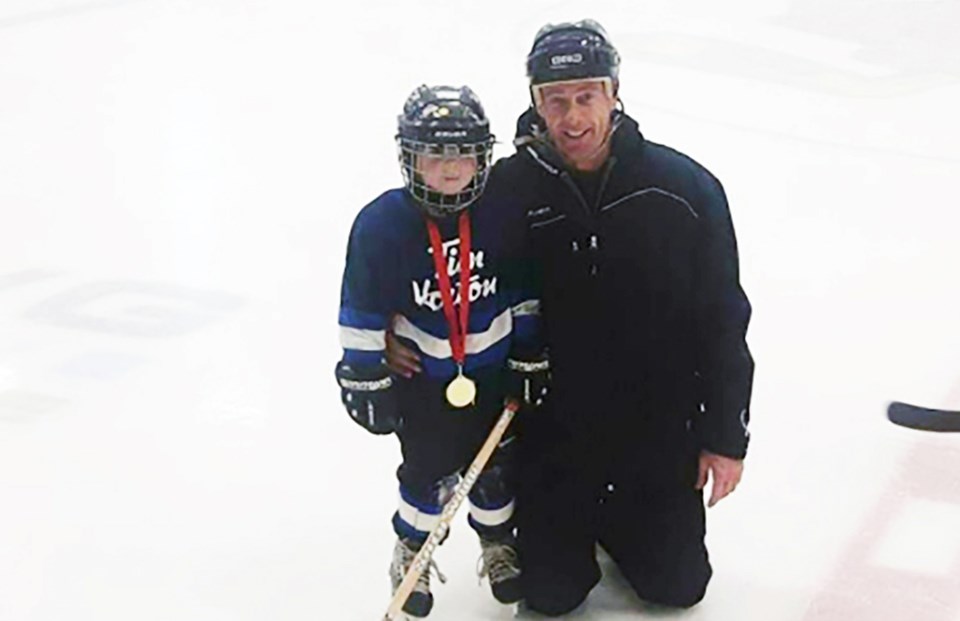Roy Chiarot has been involved in Bradford minor hockey for “pretty much 20 years, starting with my sons,” he says, coaching at every level, “starting from the bottom, pretty well to the top.”
Chiarot has coached PreTyke teams, a learn-to-skate program for kids ages three to five, all the way up to Midget level with the Hockey Association, over nearly two decades.
After nine years of serving on the Executive of the BWGMHA, and five years or so with the 11-Association, 110-team Simcoe Regional Hockey League, where he served as Vice President – “I still sit on their board to help them out, because it’s hard to get volunteers,” he says - last year, he left the Bulldogs to work with the York-Simcoe Express AAA Minor Bantams.
Many remember Chiarot not only as the coach who provided their kid’s first introduction to hockey, but as a key volunteer during the early days of Hockey Day in BWG – a celebration of outdoor hockey and pond hockey traditions.
In the days before the town took over running Hockey Day in BWG, it was Chiarot and a neighbour or two who were out in all types of weather, and at all times of day and night, helping to create the temporary ice rinks at Bond Head’s Bud Brown Memorial Park for the annual event.
The volunteers flooded the tarps provided by the Bond Head Lions Club, maintained the ice through freeze and thaw cycles, kept the makeshift rinks clear of snow, and ensured that the outdoor Tyke and Pretyke tourneys could go ahead.
Chiarot says simply: “You have to have a passion for it.”
He still has a passion for minor hockey, but this year has been like no other. Not only did his YSE Minor Bantams, like so many other teams, see their hockey season cut short by COVID-19 closures, there is now much uncertainty about the start of the next hockey season.
“Is it going to be different? This is a whole different ball game,” he says. “I don’t think we’ll see anything until August, honestly.”
Even then, arenas will likely have to make changes, to allow for physical distancing in the bleachers and in the dressing rooms, where up to 18 kids can gather.
“There will be more sanitary wipes and handwashing stations,” Chiarot says, but he is hopeful that adjustments can be made to ensure there will be the opportunity for hockey to return, and for kids to experience the lifelong friendships and the team-building that are part of the sport.
With the closures of sports facilities and fields, “the kids are the ones that are missing out,” he says. “I feel for anyone with young children who’s trying to keep them entertained. I feel for the kids now - you ask them to be active, and then they can’t go out.”
And it’s not just the physical activity.
“What’s the best part of hockey? It’s the socialization – between the kids, and between the parents,” Chairot says.
Right now, that socialization is limited to phone conversations, and online contact – but Chiarot plans to be there, when hockey does come back, and he is encouraging others to think about volunteering, to support minor sports in the community.
He hears a lot of reasons for refusal, when people are asked to step up. “The biggest thing they say is, they have no time,” he says. “I find the time, because I enjoy doing it.”
Chiarot especially enjoys watching kids develop their skating and hockey skills – and parents remember his contributions.
“You ask the parents of the kids I taught to skate, the kids with special needs…” he says. “The friendships you acquire throughout the years, now I’m going to the weddings of kids I coached.”
He continues to step up to contribute his time, patience and experience to see kids grow in hockey.
“I’ve always been one to help, not hinder,” he says. “You have to have a passion for it.”
